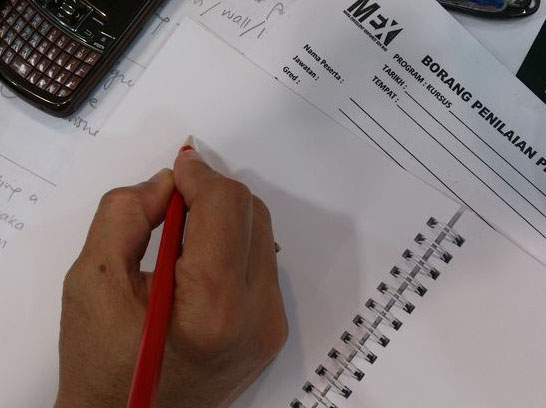雅思写作常见问题汇总 打破思维定势
- 2015年09月09日17:18 来源:小站教育作者:Phoebe
- 参与(0) 阅读(7564)
今天看到央视主持张泉灵辞职转向创投行业的消息,她说人生时不时的像是被困在玻璃缸里的,久了便习惯了一种自圆其说的逻辑。小站老师认为,很多考生在雅思写作的时候也常常陷入中式思维逻辑中不能自拔,导致分数很难提高。本文总结了考生的常见问题,全部由雅思考官来为大家讲解,希望让大家对写作有新的认识。
问题列表:
1.Q:雅思大作文都有哪些类型?不同类型的题目应该如何组织段落结构?
2.Q:开始写作文的时候思考顺序是怎么的?
3.Q: 学生问,I am confused about the question "Do the advantages outweigh
4.Q: Firstly, Secondly, Finally这样的单词用多了好吗?
5.Q:如何规划写作时间?
6.Q:平时练习写作可以参考的TOPIC LIST有吗?
7.Q: Is there any specific study order that you recommend?
8.Q:如何充分利用雅思考官的作文?
9.Q:表示“总结”的词组哪些能用哪些不能用?
10.Q:雅思写作大作文评分标准分别是什么?每一项所占的分数比重是多少?
1.Q:雅思大作文都有哪些类型?不同类型的题目应该如何组织段落结构?
A:Here are the four types of question:
1. Opinion
2. Discussion + opinion
3. Problem + solution
4. 2-part question
针对不同类型,大家需要记住的要点是:
1. An 'opinion' question asks for your view, not the views of other people, and you don't have to give both sides of the argument. Just make your opinion clear in the introduction, then explain it in the rest of the essay.
Opinion类是询问你的观点,而不是其他人的观点,所以你不必给出双方论据。只需在Introduction段落中澄清自己的观点,然后在后面解释就可以了。
2. A 'discussion' question requires you to write about both sides of the argument, and you should write a similar amount for each view. If the question also asks for your opinion, you don't need an extra paragraph. Just make it clear in the introduction and conclusion which of the two views you agree with.
Discussion类要求你写出双方观点,双方字数相近,不要偏颇。如果问题中有征询你的意见,你无需另起一段,只需在首尾段中陈述即可。
3. Type 3 is easy. Simply write a paragraph explaining the problem(s) and a paragraph explaining the solution(s). Some questions ask about 'causes' or 'effects': these would be part of the 'problem' paragraph.
Problem+Solution类很简单。主体段落只需一段解释问题一段给出解决方案即可。有些问题会问到“起因”或“影响”,这些只需写进“problem”段落。
4. For type 4, just answer the two questions. Write one paragraph about each.
2-part question类,只需主体段每段各回答一个问题即可。
2.Q:开始写作文的时候思考顺序是怎么的?
A:以下是他的思考步骤:
1. I read the question very carefully, maybe three times. I ask myself "What's the topic? What is the question asking me to write about?"(我会非常仔细地读问题,读上三遍,并自问“topic是什么,这个问题让我写什么内容?”)
2. I underline the key things that must be included in the essay. I always answer every part of the question.(我会画出重点部分,不会忽视任何一部分的问题)
3. Now I think about my 4 paragraph structure. I can write any type of essay in 4 paragraphs; I just need to decide what to put in each paragraph.(现在我思考我的4段式结构——此结构适用于任何类型的大作文,我只需考虑每段放哪些内容即可)
4. If I need to give my opinion, I think "What is the easiest opinion to explain? What good vocabulary could I use?"(如果我需要给出自己的意见,我会想“什么样的意见是最好解释的?我能用哪些高级词汇?”)
5. Then I write down some vocabulary ideas that are related to the topic.(然后我写下一些和topic相关的词汇)
6. I try to write 2 sentences for the introduction: I introduce the topic, then give a simple answer (including my opinion if the question asks for it).(我试着为Introduction段写两句话,引进主题,给出答案,如需要会给出自己的意见)
7. I write short 'topic sentences' to start each paragraph, then develop my ideas by explaining and supporting with examples.(我写主题句引出每个段落,然后通过解释和举例来延伸观点)
8. I look at the question from time to time in order to check that I'm answering every part of it.(我不时看一遍问题为了确保回答了每一个部分)
9. I know that I write about 10 words per line; I can quickly check the approximate number of words that I've written.(我知道我每句写10个单词,我能快速计算出我大概写的字数)
10. If I need more words (to reach 250), I expand one of my examples in the main body paragraphs. If necessary, I draw an arrow to show where I want to add the extra words.(如果我需要写到250字,我会扩展主体段中的例子。如有必须,我画个箭头标记我想插入内容的位置)
3.Q: 学生问,I am confused about the question "Do the advantages outweigh the disadvantages?". Is this an opinion question or discussion + opinion question?
A:之前我们有讲过Simon把文章分成四大类,不同类型的作文其段落内容是不同的,所以有学生问了,像这种问法的作文是属于哪个类型的。以下是Simon的回答:
Strictly speaking, "Do the advantages outweigh the disadvantages?" is asking for your opinion (do you think there are more advantages or disadvantages?). Technically, you could give a one-sided "opinion" answer e.g. you could argue that there are many advantages and almost no disadvantages.
However, I think the examiner would expect and prefer to see a balanced discussion of both sides as well as your opinion. Therefore, I think it's best (and easiest) to write a discussion + opinion essay.
4.Q: Firstly, Secondly, Finally这样的单词用多了好吗?
A:Simon是这样回答的,It's best not to use "Firstly, Secondly, Finally" twice in one essay. If we wanted to write a second main paragraph with three ideas, what could we used instead of "Firstly, Secondly, Finally" to organise them?
也就是说,这组词最好不要用两次。那么有什么能替代它们呢?然后Simon写了一个Example,让大家找一下他用了哪些词语替换的这组顺序词:
Three main factors are affecting health in modern societies. One problem is the lack of awareness among many people of the negative consequences of an unhealthy diet. This is made worse by the prevalence of fast food and processed food, which are full of fat, salt and sugar. Another key factor is the changing trend in lifestyles. For example, children’s hobbies now involve much less outdoor activity, and adults are less active as jobs have shifted towards sedentary office work instead of manual labour. In addition to this, time-saving technologies, such as cars, elevators, dishwashers and washing machines, have made people lazier.
Simon写得这段完全没有用到Firstly,Secondly,Finally,但是整个叙事逻辑有序,原因就是他第一句就表明有three main factors。介绍这三个因素的时候依次用one problem is…another key fator is…in addition to this…来表达,连贯清晰,大家可以充分借鉴,避免过多重复。
5.Q:如何规划写作时间?
A: You have 40 minutes for writing task 2, and I suggest that you:
· Spend the first 10 minutes planning your essay structure and brainstorming ideas for the two main body paragraphs.
· Spend 5 minutes writing your 2-sentence introduction.
· Spend 20 minutes on the main body (10 minutes for each paragraph).
· Spend the last 5 minutes writing your conclusion and checking everything.
6.Q:平时练习写作可以参考的TOPIC LIST有吗?
A:
1. Advertising
2. Animal Rights: testing on animals, vegetarianism, zoos
3. Cities: urbanisation, problems of city life
4. Crime: police, punishments/prisons, rehabilitation, capital punishment
5. Education: studying abroad, technology in education, education in developing countries, higher education, home-schooling, bad behaviour, corporal punishment, single sex education, streaming (grouping children according to ability)
6. Environment: global warming, impact of humans on the environment, solutions to environment problems, waste/rubbish, litter, recycling, nuclear power
7. Family: family size, working parents, negative effects on children, divorce, care for old people
8. Gender: gender and education, gender and work, women’s and men’s role in the family
9. Genetic Engineering: positives, negatives, genetically modified foods
10. Global Issues: problems in developing countries, how to help developing countries, immigration, multi-cultural societies, globalisation
11. Government and Society: what governments can do, public services, censorship, video cameras in public places
12. Guns and Weapons: gun ownership and possession, police and guns, nuclear weapons, armed forces
13. Health: diet, exercise, state health systems, private healthcare, alternative medicine, stress
14. Housing and Architecture: state housing, old buildings, modern/green buildings
15. International Language: English as an international language
16. Money: money and society, consumerism
17. Personal Development: happiness, success, nature or nurture
18. Sport and Leisure: professional/competitive sport, sport salaries, sport and politics
19. Tourism: positives, negative effects on environment, future of tourism
20. Traditions and Modern Life: losing traditional skills, traditional customs
21. Transport: traffic problems and solutions, public transport, road safety
22. Television, Internet and Mobile Phones: positives and negatives, Internet compared to newspapers and books
23. Water: importance of clean water, water supply, water should be free, bottled water
24. Work: same job for life, self-employment, unemployment, work/life balance, technology and work, child labour
7.Q: Is there any specific study order that you recommend?
A: 1. Essay structure and paragraphs
The first thing to do is find an essay structure that works for you. You probably know that I prefer to write 4 paragraphs, and maybe you've seen how I write 2-sentence introductions, 5-sentence main paragraphs and 1-sentence conclusions. Try this: take some essays that you have already written, and rewrite them so that they all have the same number of paragraphs and sentences.
首先要想好文章的Structure。Simon喜欢写4段式——开头两句,主体段落各五句,结尾一句。大家可以尝试将之前写好的作文都重新写成这种结构。
2. Question types
You need to see examples of the four question types, and make sure you know how to answer each type using your preferred essay structure.
平时多看大作文四种类型的范文,针对题目类型,选用合适的Structure。
3. Planning, and isolated paragraph practice
Take several different questions, and practise planning ideas. Then spend some time focusing only on introductions e.g. write an introduction for five different questions. Then do the same with conclusions. Then try writing different types of main paragraph e.g. an 'advantages' paragraph, an 'opinion' paragraph, a 'problem' paragraph etc.
选一些题目,练习planning ideas.比如可以写五篇不同题目的introduction,或者写不同类型题目的主体段落。
4. Topic ideas
When you are confident that you know how to write an essay, it's time to start working through as many common IELTS writing topics as possible. Even if you don't write a full essay for each topic, you should at least plan some ideas and opinions.
当你足够自信到知道如何写文章的时候,你就可以尽可能多地写各种不同题材的常见写作题目。参考见上个问题
5. Mistakes, corrections and improvements
Try to find someone who can check your writing, highlight and explain your mistakes, and show you how to improve your essays.
找个能帮你检查作文的小伙伴,能指出错误并告诉你如何改善。
8.Q:如何充分利用雅思考官的作文?
A: Try this exercise using my essay :
1. Read the essay and make sure you understand it.
2. Read it again slowly, and make notes on a separate piece of paper. Just write the main idea or key words from each sentence (there are only 13 sentences in the whole essay).
3. Hide my essay, and try to rewrite it using only your notes. Don't try to memorise the essay exactly as I wrote it; the aim is to see if you can write a similar essay using the same key ideas.
4. Compare your essay with mine. Did you write the same number of sentences? Did you include the same key vocabulary? Did you use the vocabulary correctly? Does your essay 'flow' as well as mine does?
You can learn a lot by doing this exercise.
9.Q:表示“总结”的词组哪些能用哪些不能用?
A:When writing a conclusion for task 2, I always start with the words "In conclusion". There's no reason why you should learn any alternatives.
Here are some phrases that I would not use:
1. All things considered
2. To sum up
3. In summary
4. To summarize
5. In short
6. In a nutshell
7. To put it in a nutshell
Note:
Phrases 1 to 5 are acceptable, but I still wouldn't use them myself.
Don't use any phrase containing the word "nutshell". 6 and 7 are not appropriate for an academic essay.
10.Q:雅思写作大作文评分标准分别是什么?每一项所占的分数比重是多少?
A: Here's a simplified version of the marking system for IELTS writing:
Note:
I tell my students that the fastest way to improve their scores is by focusing on 'task response' and 'lexical resource'. You do this by explaining your ideas / views in more detail.
从上就是小站老师为大家整理的雅思考官对于雅思写作大作文常见问题的解答,希望大家都能打破思维定势,写出高分作文!













































